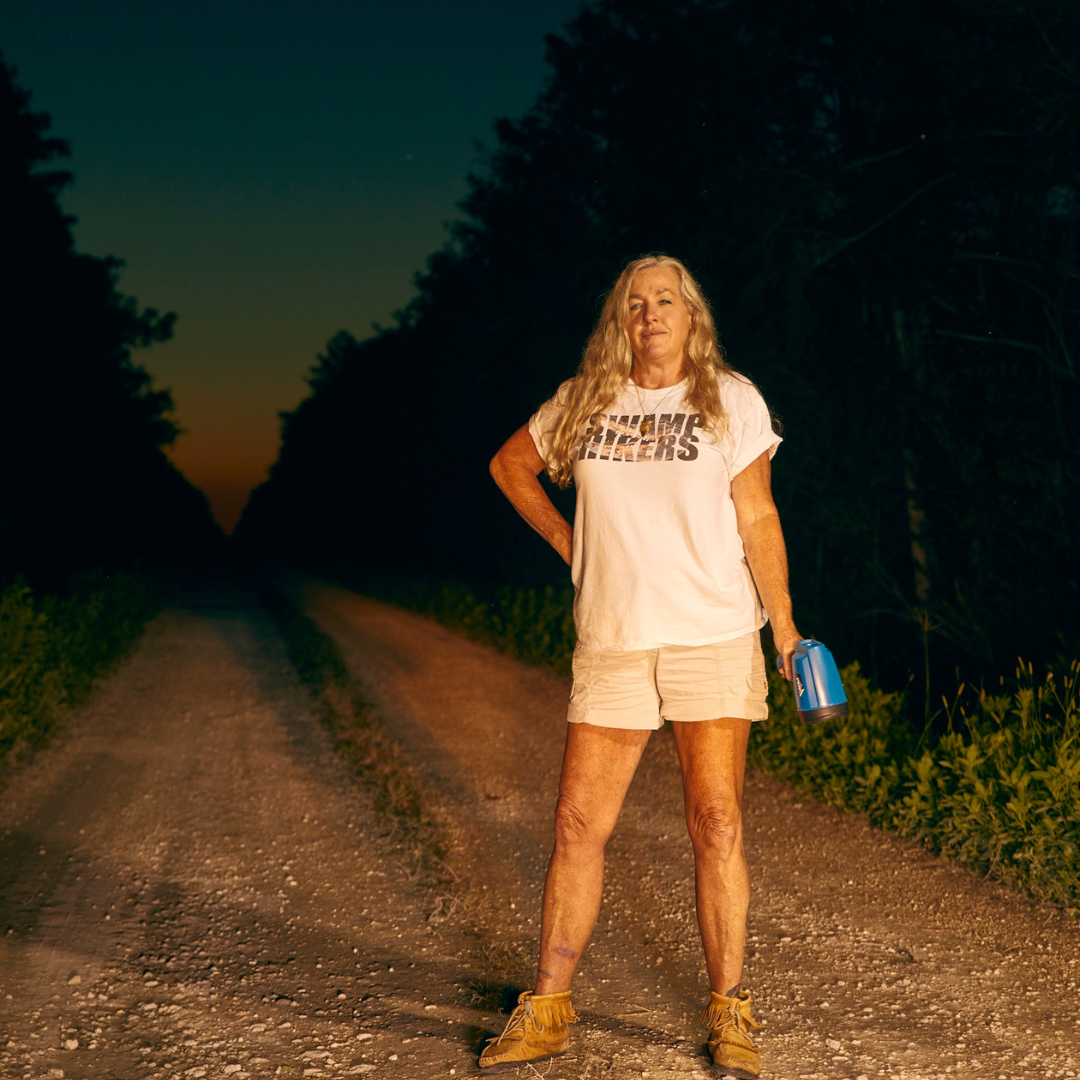by Emily Bloch | February 11, 2019
Parkland: The Faces of Change
Conversations with survivors of the Marjory Stoneman Douglas school shooting and how they continue to shape the national debate one year later.


Valentine’s Day, a day that is supposed to revolve around love and romance, now marks the one-year anniversary of one of the deadliest mass school shootings in modern history.
On Feb. 14, 2018, 17 people died at Marjory Stoneman Douglas High School in Parkland, a quiet city named one of the state’s safest only days before the tragedy. What followed has been nothing less than a tsunami of activism around common sense gun legislation, school security and mental health issues led by a group of teens who survived. Flamingo caught up with some of the changemakers to find out where they are now and what’s changed in the last 12 months.
A MOVEMENT IS BORN
Survivors—including Delaney Tarr, David Hogg, Jaclyn Corin, Alex Wind, Cameron Kasky and Emma González—founded March for Our Lives, a movement dedicated to ensuring what happened at their school never happens again, giving rise to the hashtag #NeverAgain. The student activists spoke out, championing a need for stricter gun control and quickly becoming household names.
Like what you read? Click here to subscribe.


“I didn’t really have a choice but to get involved,” said Tarr, who was a senior at the time of the shooting. “When a tragedy happens to you, you never know how you’ll react. For me, my method of coping with grief and trauma was to speak out. I felt comfortable giving speeches, doing interviews. It distracted from something I couldn’t deal with and created a spark of change.
Multiple books have been penned by the survivors and more are in the works, though many of the details remain secret, according to those involved with March for Our Lives.
“One of the main reasons I wrote the book was because I wanted to make sure my friends are remembered,” said Lauren Hogg, who along with her brother, David, wrote #NeverAgain: A New Generation Draws The Line.“All the money is being donated to gun violence organizations. It was therapeutic. The results, the feedback we’ve been getting has just been amazing.”
The students who founded March for Our Lives were honored by the Smithsonian with a 2018 Ingenuity Award and made Time’s Person of the Year shortlist.


“It’s crazy we could all gather together to do something we’re so passionate about,” said Adam Alhanti, a high school senior and the director of special projects for March for Our Lives. “It’s fantastic, even though it’s heart-breaking. It’s fantastic that I get to surround myself with these people.”
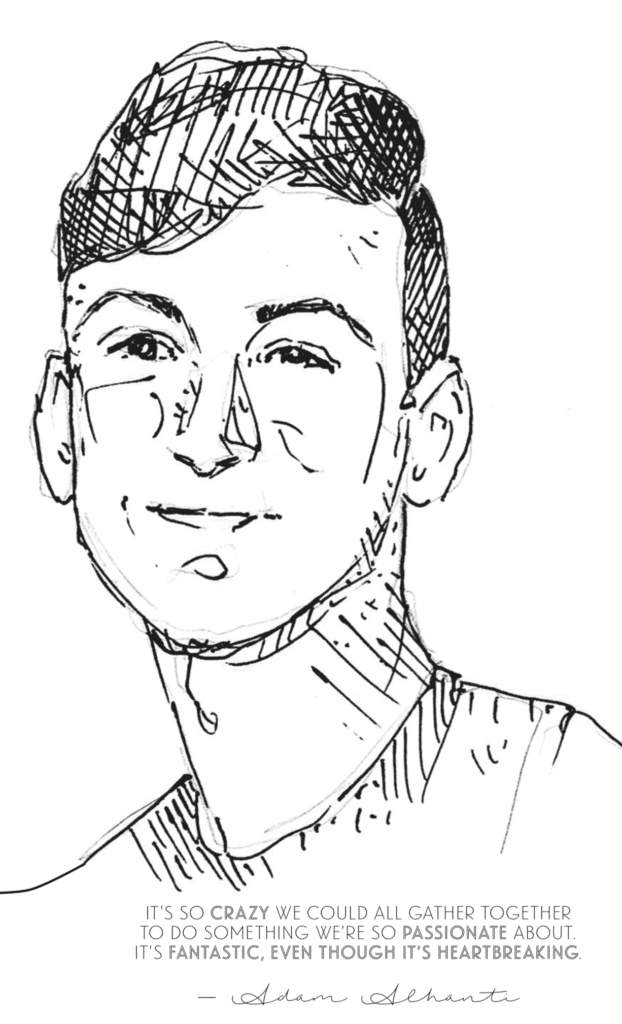

FAME AND FURY
But along with the thousands of Twitter followers, fan art and magazine covers came an onslaught of criticism.
Shortly after the shooting, a conspiracy theory emerged from the underbelly of the internet, calling the survivors “crisis actors.” By the end of 2018, the accusation was deemed “Lie of the Year” by the Poynter Institute’s fact-checking project, PolitiFact.
A fake video of Emma González made waves on the internet, showing the teen ripping up a copy of the Constitution, and politician Leslie Gibson dropped out of the race for Maine’s House of Representatives after calling González a “skinhead lesbian.”
“They’re either misunderstanding our movement or they’re just complaining and they’re not doing anything—which, ultimately, a couple of complaints aren’t going to hurt the cause,” Tarr said in an interview with Vox last year. “It’s an inevitability when you are doing something this big and this controversial for so many people. Even though it shouldn’t be controversial.”
David Hogg was at the center of those conspiracy theories, with internet trolls and skeptics claiming that the 18-year-old was a paid actor from California and not an actual high school student. Accusers said that he was backed by radicals.
“I remember first finding out about the crisis actor thing,” said Lauren Hogg who’s now a sophomore at Stoneman Douglas. “I kind of laughed, but then I started getting more comments on Instagram and death threats about me and my brother.”
The students even got a shoutout in a now-infamous Louis CK set in which the comedian made fun of the survivors’ popularity.
“You’re not interesting because you went to a high school where kids got shot,” the comedian said during a new stand-up routine. “You didn’t get shot. You pushed some fat kid in the way and then, now I got to listen to you talking?”
Tarr quickly shot back.
LEAVE LOUIS CK IN 2018. WE’RE NOT TAKING THIS ENERGY INTO 2019. thank u.
— Delaney Tarr (@delaneytarr) December 31, 2018
“We’ve worked with plenty of comedians who have talked about us in a genuine, hilarious way,” she tweeted. “This is just being a dick.”
For Tarr and her March for Our Lives peers, there’s a constant struggle between adjusting to their newfound platform and coping with how they got it in the first place.
“We get called superheroes. I understand where that comes from, but I don’t think it’s a fair term,” she said. “This work isn’t easy, and it takes its toll on teenagers who are still learning how to live a life irreparably changed. The more we are viewed as celebrities, as the saviors, the less people understand who we really are. We are young people who desperately want to change our country.”
CHANGE IS COMING
Jeff Foster didn’t know he had been preparing his students for this important work all school year long. He teaches Advanced Placement U.S. government and politics, covering issues like gun legislation, government policy and special interest groups.
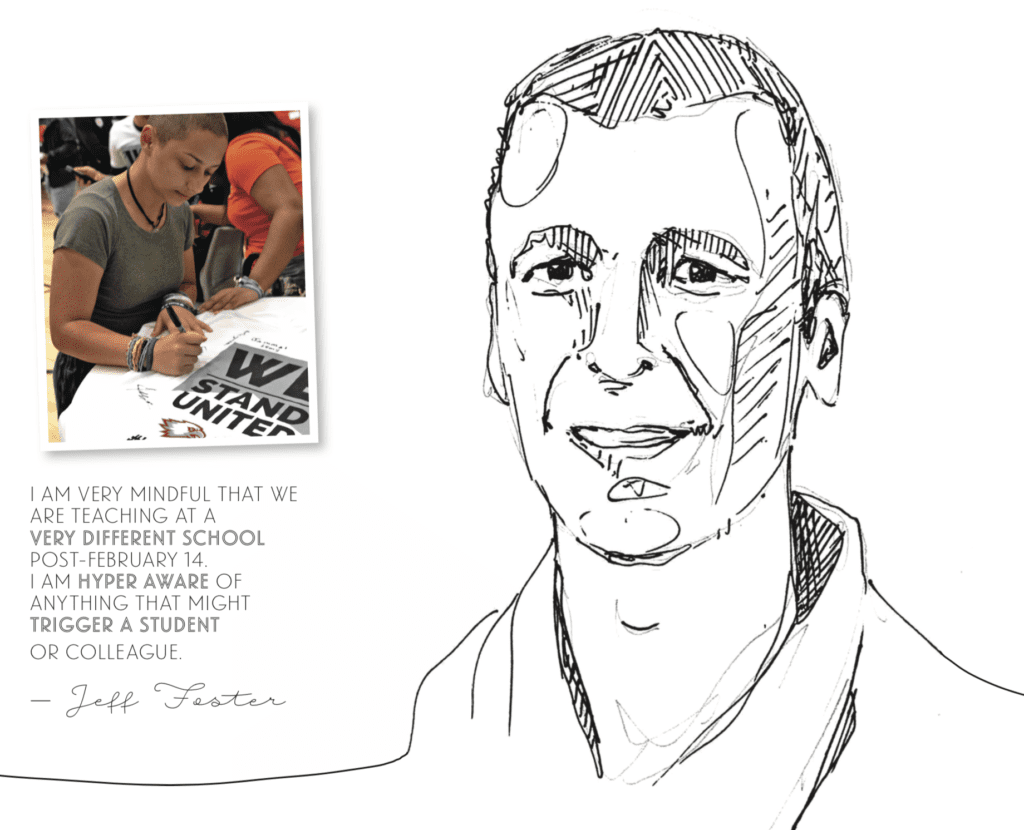

Foster, an educator at Stoneman Douglas for about 20 years, resembled a boxing coach watching his students use talking points from his class during town hall events and public speeches. Today, he continues to work with his former and current students on March for Our Lives efforts.
“I still speak to and advise, when asked, most of my former students,” Foster said. “I will always be available to them.”


For Foster and the rest of the Stoneman Douglas faculty, almost everything has changed. “I, along with the rest of the staff, am very mindful that we are teaching at a very different school post-February 14,” the teacher of eight classes and 233 high school seniors said. “I am hyper-aware of anything that might trigger a student or colleague and have changed some of my curriculum due to the event.”
When Foster plays a video clip for class, he mutes the segments where gunshots are audible. In his spare time, he serves as a committee member of Ban Assault Weapons Now, an organization focused on adding an amendment banning assault weapons in Florida to the state’s 2020 ballot. He serves alongside victims’ parents and Congressman Ted Deutch, a Democrat whose district includes Parkland and Stoneman Douglas.
“I still believe we are very vulnerable and we have a lot of work to do to make our schools as safe as humanly possible,” Foster said. He’s already seen textbooks with pictures from the school shooting included.
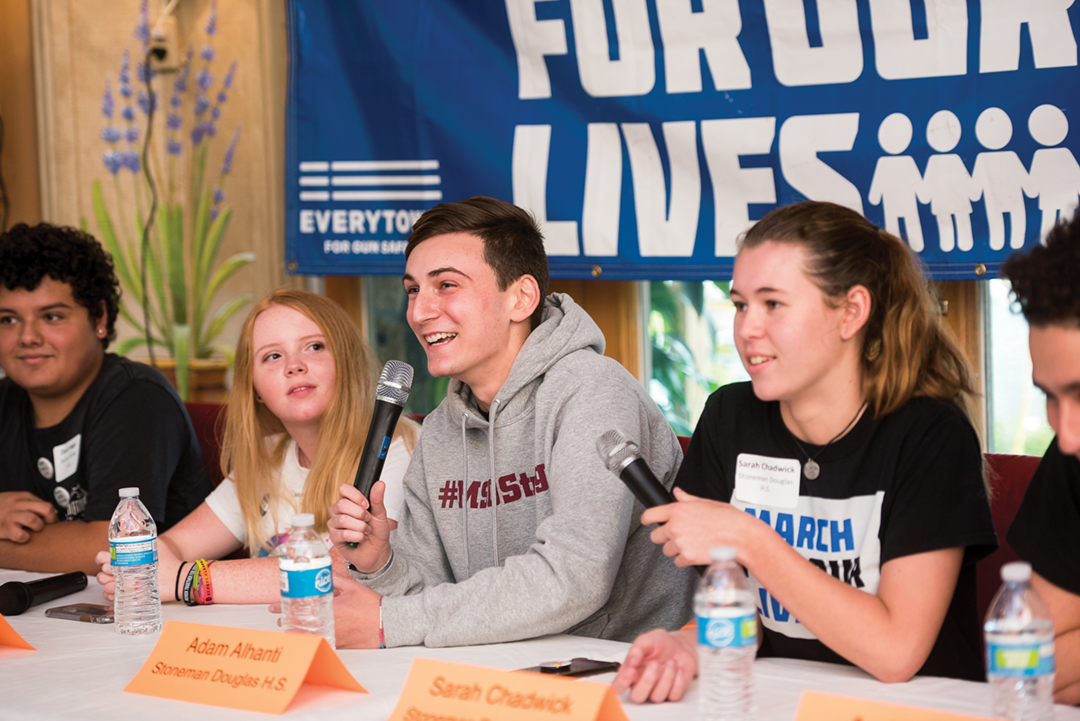

Another likely future addition to textbooks? The policy changes that followed the tragedy.
Last year, less than a week after the school shooting, busloads of Stoneman Douglas students took their concerns to Tallahassee. It was a scene reminiscent of students preparing for a field trip to a theme park on grad night, loading up onto charter buses with their duffel bags. But for the survivors, this adventure carried so much more weight than any trip to Disney World or Universal Studios ever could.
The students visited the Capitol, joined a gun control rally, held press conferences, observed Senate action and met with lawmakers including then-state Rep. Jared Moskowitz—a Democrat from Coral Springs and a graduate
“We’ve seen this show before,” Moskowitz said in an interview with the Miami Herald following the shooting. “Now it’s in my hometown.”
Moskowitz, recently appointed the director of the Division of Emergency Management by Gov. Ron Desantis, played a key role in the passing of a landmark statewide bill that raised the minimum age for purchasing a rifle from 18 to 21 years old and established a three-day waiting period. The bill was signed into law by former Gov. Rick Scott in March.
“I would have liked an assault weapons ban,” Moskowitz said in an interview with the Sun Sentinel editorial board. “Of course I would have. But that bill was not on the table.”
Since then, additional changes have come down the pipeline as a direct reaction to Parkland. Administrators were reassigned to new schools, the Broward County sheriff was replaced and President Donald Trump banned bump stocks.
“This is amazing,” Tarr tweeted at the time the ban was announced. “Thank you so much for supporting us. We have a lot to do, but progress is progress.”
We got bump-stocks banned!!!
— David Hogg (@davidhogg111) December 19, 2018
Shout out to all the amazing @AMarch4OurLives chapters that got people to comment on ATFs website to ban bump-stocks.
Others felt it was about time. “We all feel amazing that it’s gotten passed but some of us are more relieved because this should’ve happened long ago,” Lauren Hogg said.
“We’re taking the small victories and keep going forward.”
In January, the student leaders continued to go forward, as they stood on Capitol Hill alongside Speaker of the House Nancy Pelosi.
On Jan. 8, David Hogg, Corin, Charlie Mirsky—another student survivor—and others unveiled a universal background check bill with the House Democrats. The bill was one of the first introduced in the new Congress.
“Today we’re just celebrating background checks,” said Mirsky, who serves as a director for March for Our Lives. “Americans across the country should be expecting more in the next couple months.”
ROCKING THE VOTE
The same students who organized a global march and concert less than a month after their school was the site of a mass shooting also helped spike a surge in youth voters, according to reports.
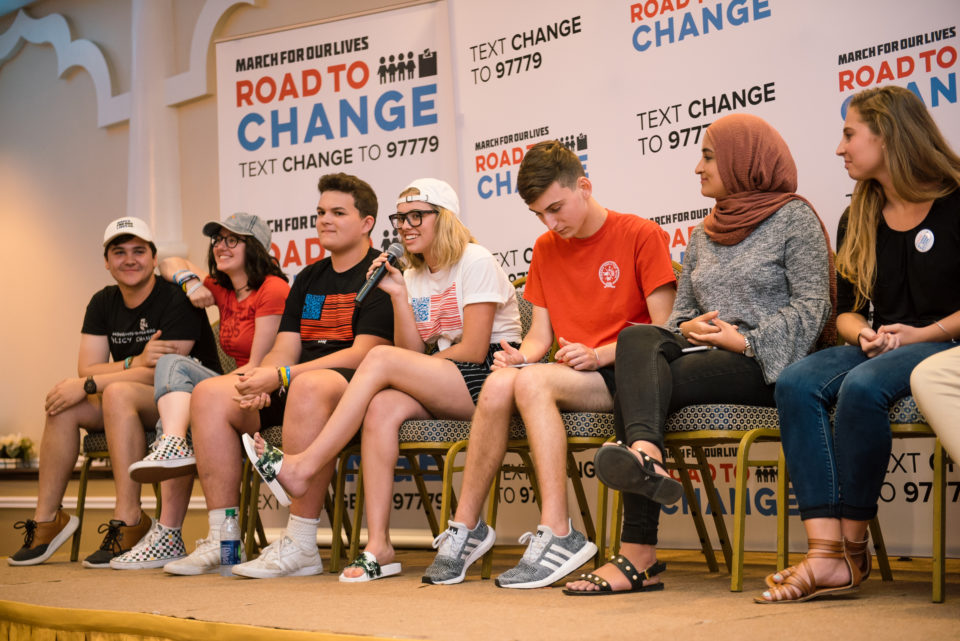

Student leaders, including the Hogg siblings, Delaney Tarr and Emma González, jumped on the “Road to Change”—a nationwide tour the students organized where they met with young people and helped them register to vote.
“We traveled to communities all across the country for two months, getting every person possible registered to vote, Tarr said. “After that exhausting and rewarding summer, we took on a variety of get out the vote projects.”
The 2018 young-adult turnout surged by 188 percent in early voting compared to 2014 according to reports. Media outlets deemed the uptick “the Parkland Effect.”
“We’ve seen monumental changes, not only in policy but the mindset of young people,” Lauren said. “I think young people know now that they have the power to change things they don’t like. We kind of refreshed their memory.”
A report by the data analysis group TargetSmart said that after Feb. 14, 2018, the share of youth registrants across the country increased by 2.16 percent within five months.
“The youth of our country took democracy back in our hands,” Adam Alhanti said. “Numbers of young voters have been through the roof. It’s crazy to see how many people are taking charge because of what they saw happen in Parkland, thousands of miles away.”
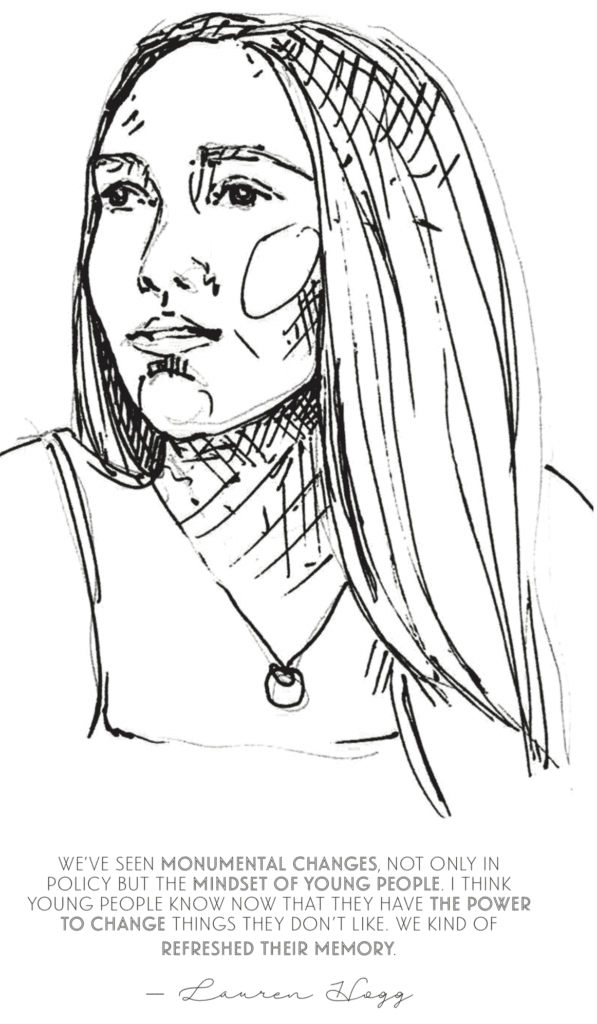

WHERE ARE THEY NOW?
Broward County Public Schools deemed Feb.14, 2019 a “Day of Service and Love” at the school, a half-day for Stoneman Douglas students and staff, devoted to service projects, offering therapy dogs, massages, cooking demonstrations and manicures to students and staff. A county-wide moment of silence is also scheduled for that morning.
Students like Alhanti, however, are already thinking well past February.
“We’ve seen changes with the 2018 midterms, but we’re not slowing down,” Alhanti said. The high school senior has been juggling March for Our Lives responsibilities with college tours over the past six months. “We’re so geared up for 2020 elections, and we know we’re going to make a difference. If you thought we made a difference already, you’re not ready for what’s to come.”
Over the past year, many of the student survivors who started March for Our Lives have packed their bags for college. Corin and David Hogg will attend Harvard University this fall. González attends New College in Sarasota, and Tarr recently started at the University of Georgia.
“Many of us are in school or going soon, while others have taken gap years. Since I moved away recently, I don’t get to see everybody from the March as frequently, and it makes me a little bit homesick,” Tarr said. “But I know that when I come back I have my own little family waiting for me, ready to make some more change.”
Meanwhile, 15-year-old Lauren Hogg just wants to enjoy high school.


“I need to take it day by day. I’m the youngest one in March for Our Lives,” she said. “[I’m] enjoying my time with these people and realizing how amazing it is we’ve created something so beautiful.”
Back in Parkland on a sunny January afternoon, violets, marigolds and fuchsia tulips bloomed around a freshly minted sign with a new school logo for Marjory Stoneman Douglas High School.
The Project Grow Love memorial garden, planted with flowers in every color and decorated with painted stones with each of the 17 victims’ names, replaced a patch of land near the school’s entrance that a few months earlier was blanketed with cards, candles and memorial balloons.
Students and members of the community gathered together, just as they had 11 months prior. Now, in a place where so many lives were lost, hope and love blossomed.
Illustrations by Jenna Alexander



